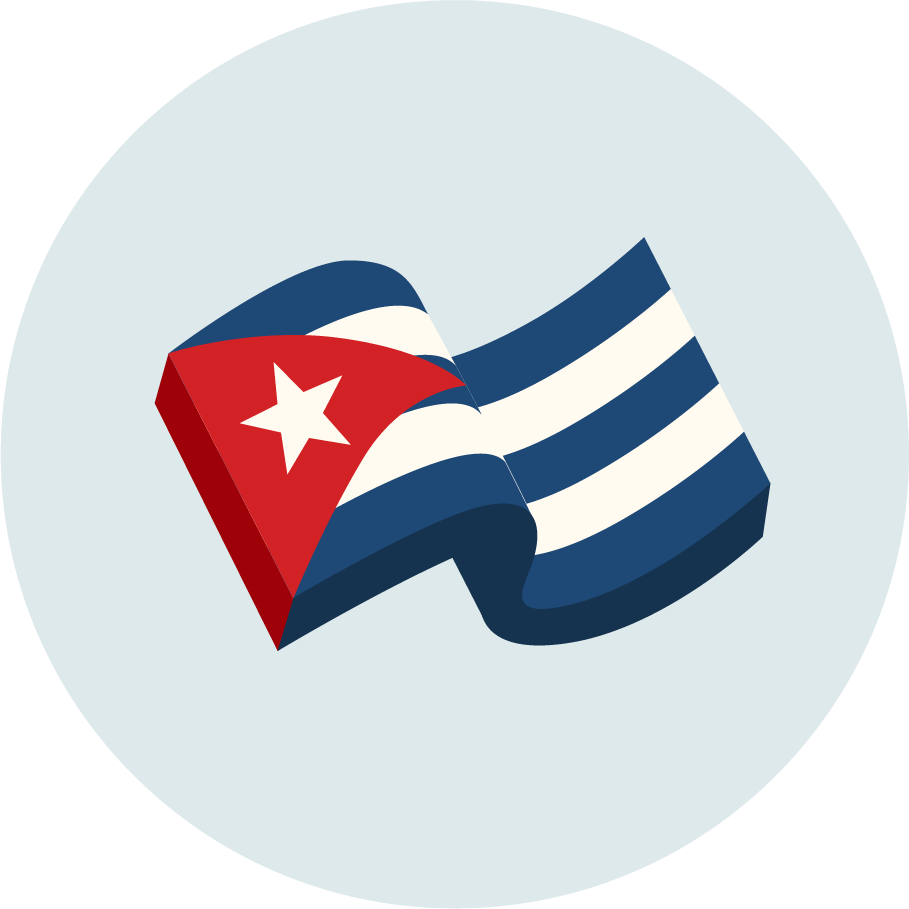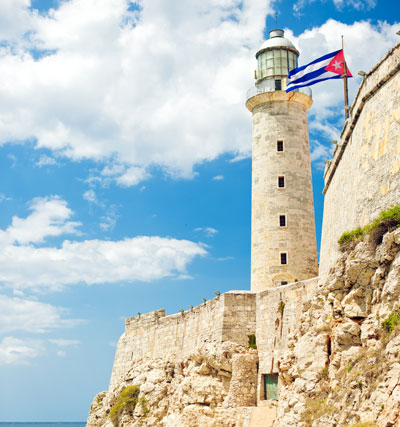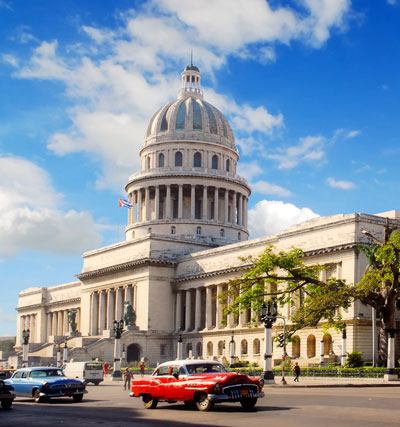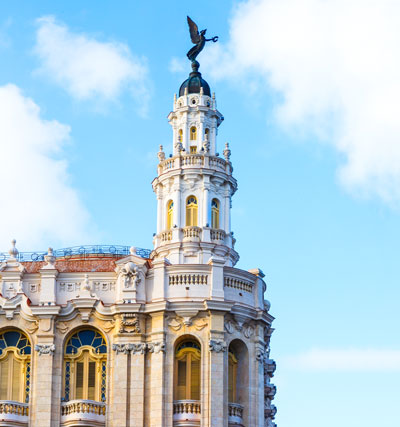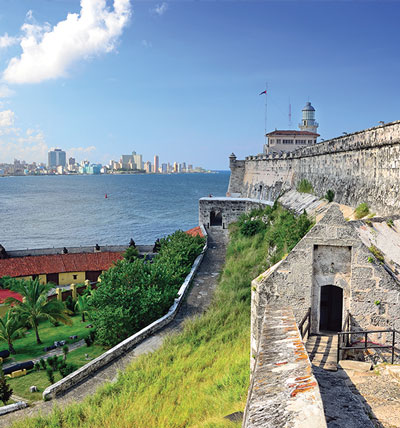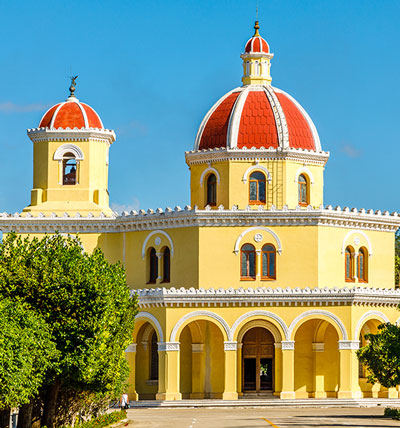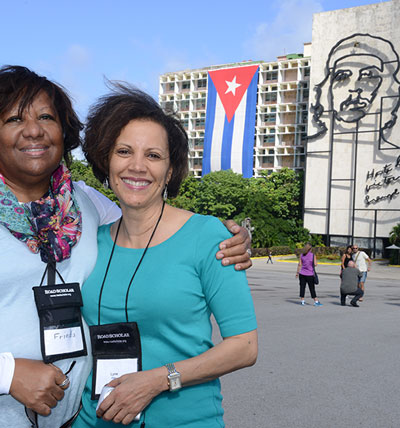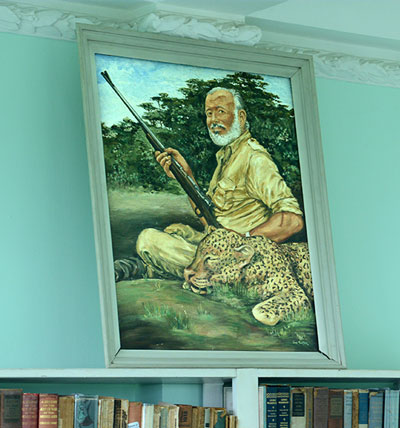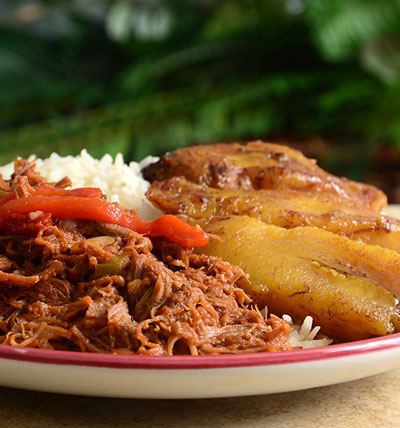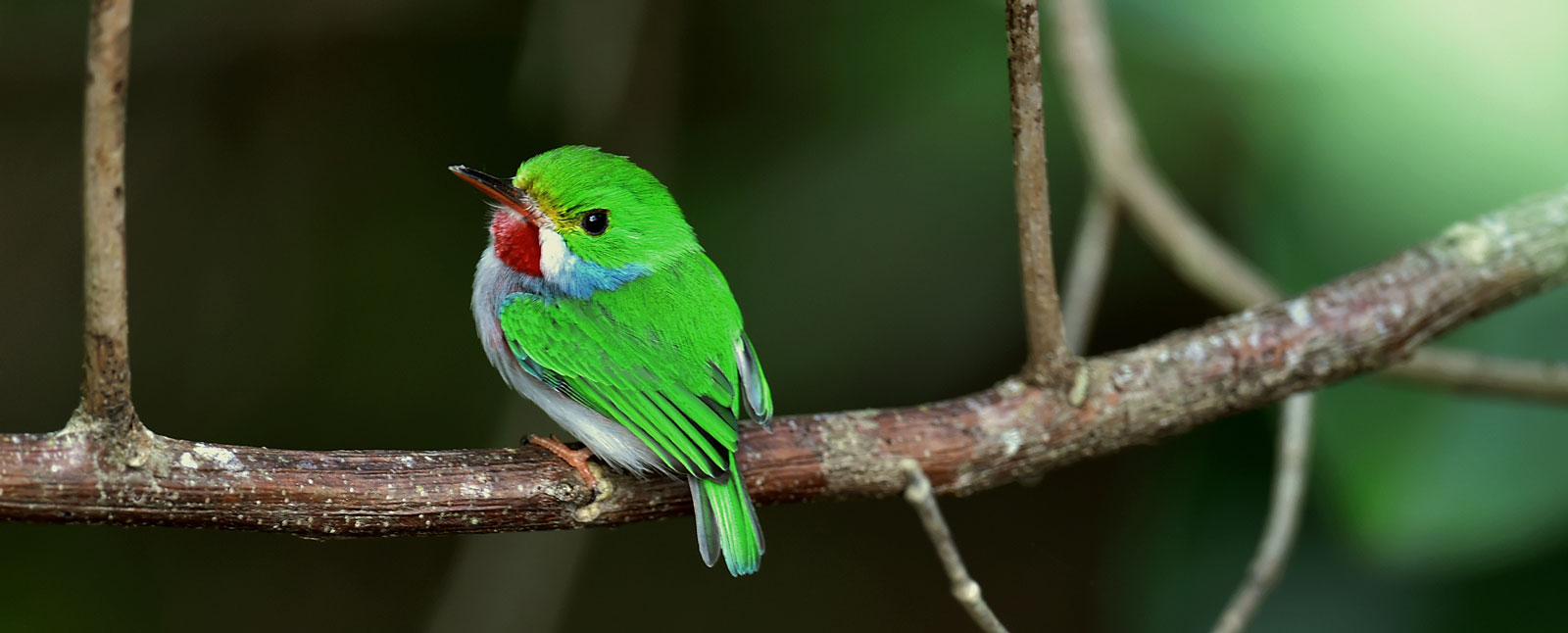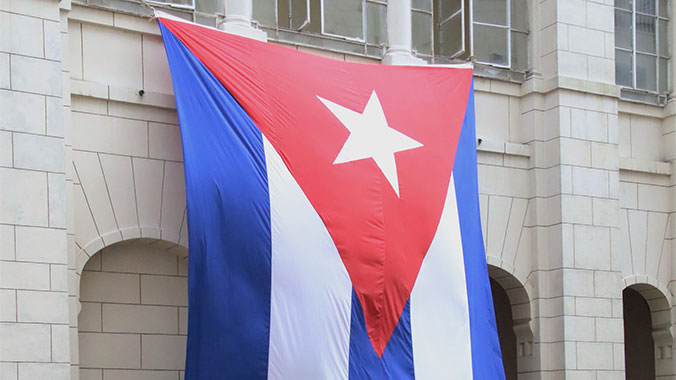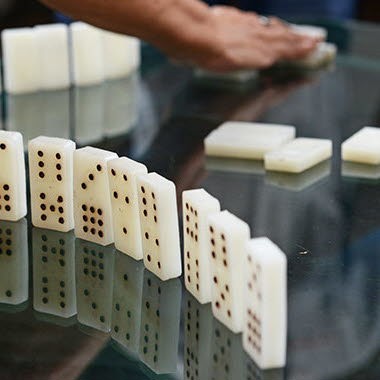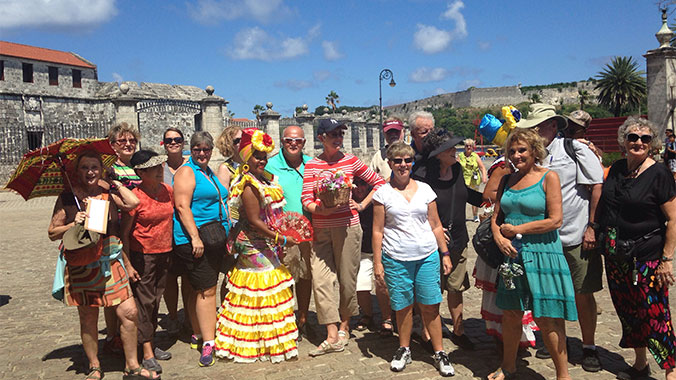Cuba: An Educational Travel Guide
Facts, travel tips, what to expect when traveling to Cuba, and more!
Educational Group Travel to Cuba
Road Scholar has been taking seniors on educational trips to Cuba since 1997, and our experts help navigate the complex rules and regulations around travel to the island.
We hope this Cuba travel guide answers all the questions you may have before you embark on your journey. Read on to discover our Cuba travel tips and learn more about this intriguing destination.
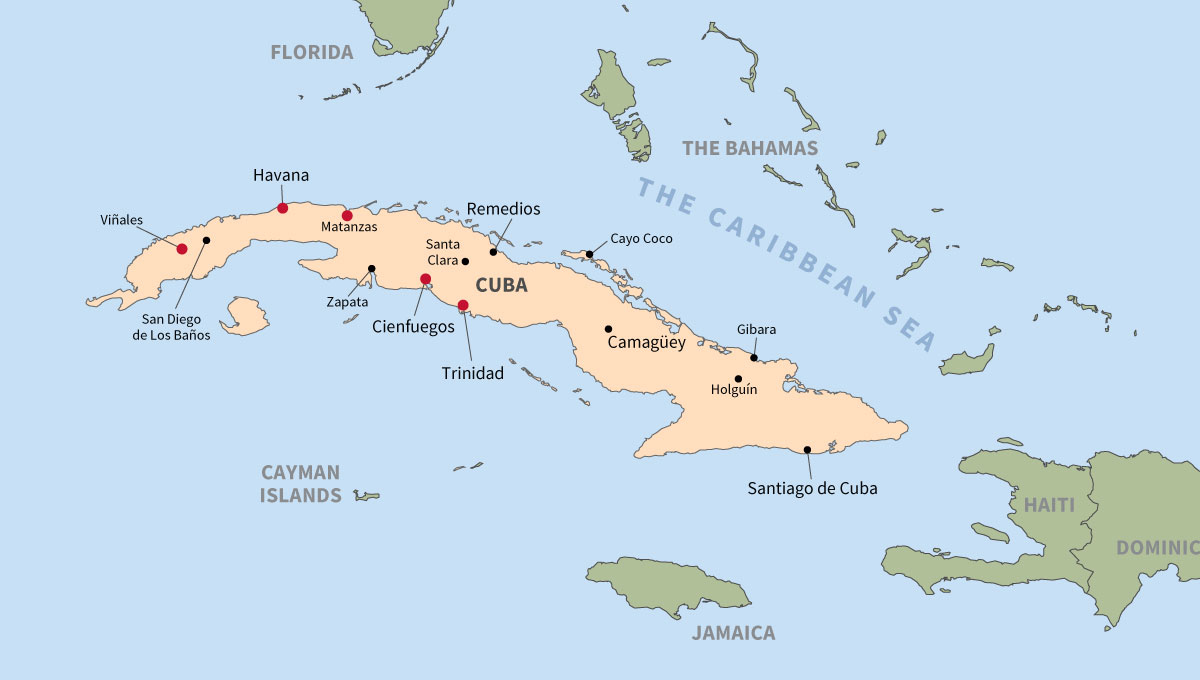
- Population: 11.27 million
- Language: Spanish
- Capital: Havana (population 2.1 million)
- Currency: Peso (CUP) and MLC Cards
MLC cards are used by Cubans to pay for specific goods and services. Euros are the preferred foreign currency, although US dollars are readily accepted for transactions with private businesses. US credit cards are almost never accepted, so it is advised to bring US dollars to pay for all of your expenses and purchases.
- Time Zone: UTC-5 (Same as Eastern Standard Time)
- Size: 42,426 square miles – the 17th largest island in the world
- Major Cities: Havana, Santiago de Cuba, Camagüey, Holguín, Guantánamo, Santa Clara, Cienfuegos, Vinales
“Your view of Cuba (and maybe the world) will find new clarity and joy. Trust me, you must go and experience Cuba yourself... and Road Scholar is the best way for the average person to do it.”
— Robert from Twin Falls, Idaho —
Weather in Cuba
Cuba has a tropical climate because of its location south of the Tropic of Cancer, in the northern Caribbean Sea near the Gulf of Mexico. The island’s weather goes through wet and dry seasons, with hurricane season occurring from August to October.
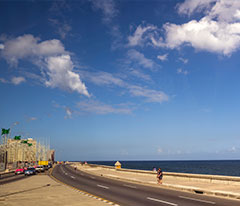
The dry season in Cuba offers pleasant temperatures in the mid-60s and 70s, with little rain. Since Cuba is close to the Tropic of Cancer, the trade winds keep the heat down and offer a nice reprieve from the humidity that usually sits at around 80 percent.
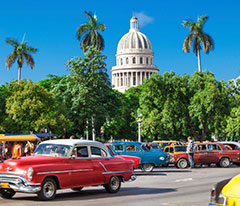
The rainy season is usually mild, so it’s still a great time to visit. And the occasional Cuban thunderstorm is a rare spectacle.
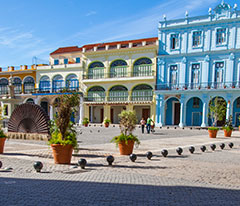
The only thing to watch out for is Cuba’s hurricane season, which encompasses August through October. Besides that, Cuba’s climate is tropical, sunny and downright gorgeous!
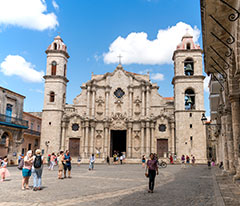
Our best Cuba travel tip is to visit Cuba during the dry season, when temperatures are most comfortable. If you’re planning a trip to Cuba for anytime between November and April, make sure to book accommodations early, as it’s a popular time of year to visit.
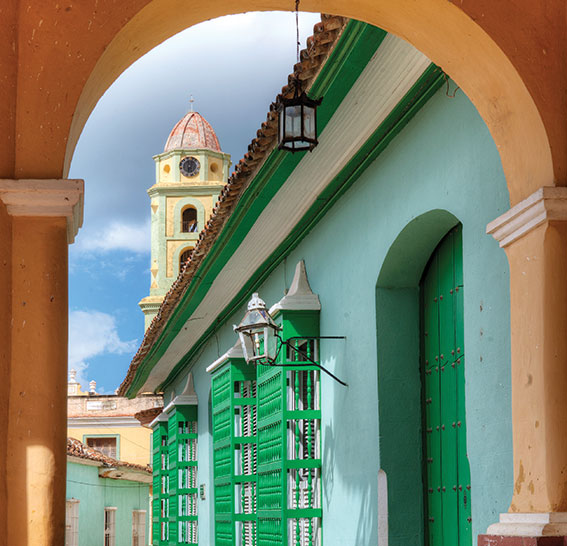
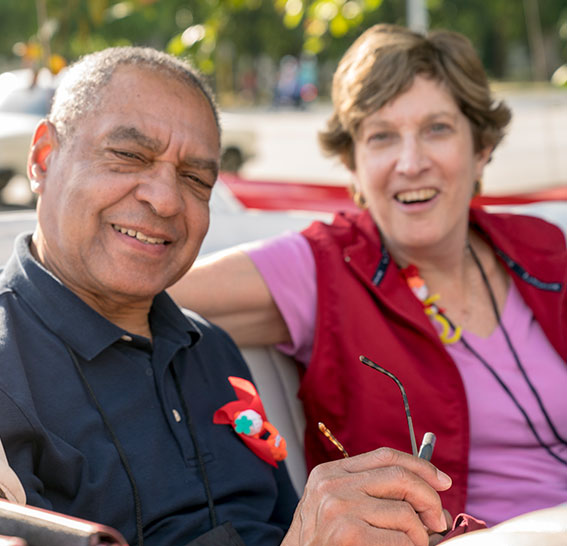

A Guide to Cuban Culture

Cuba’s official language is Spanish and it is spoken by the majority of the island’s population. However, it can differ from general Latin American Spanish in terms of intonation, due to its African influences. English is also commonly spoken in larger cities and areas frequented by tourists. Other minor Cuban languages include Haitian Creole, Lucumi (a Yoruba dialect), Galician and Corsican (both of European origin).

The basic Cuban diet makes use of both Spanish and African foods and spices. Cuban food frequently uses beans and rice as the base, but they mix in fried plantains, cucumbers, pork, chicken and potatoes to spice things up. Where Cuba really stands out is with its sweets. Cubans famously have a sweet tooth, and they savor special occasions when they get to eat cake. They fervently believe their national ice cream manufacturer “Copelia” makes the finest ice cream in the world.
Additionally, tap water is not safe to drink, but thankfully, you’ll have plenty of other tasty options! Cubans are very fond of their rum, and it’s used in the island’s most popular drinks like the Cuba Libre and Mojito. Cuban coffee is also world famous. Café Cubano has far more caffeine and sugar than its American counterpart, so even though it may be a shock, our top food travel tip is to try this tasty drink. Besides that, Cuban soft drinks are widespread, the most popular being Jupino, a sweet pineapple soda.
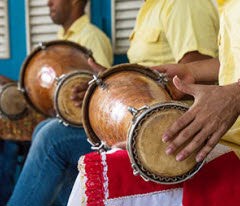
Cuba’s music is rooted in many different cultures and each region dances to the beat of its own drum. Instruments, performances and dance are most heavily influenced by West Africa and Spain but over time the island has picked up on diverse genres from many other countries. Cuba has greatly contributed to the worldwide popularity of jazz, salsa and rumba. The son cubano, a late 19th century genre blending Spanish guitar with Afro-Cuban percussion and rhythm, still provides the foundation for many forms of modern Cuban music today.
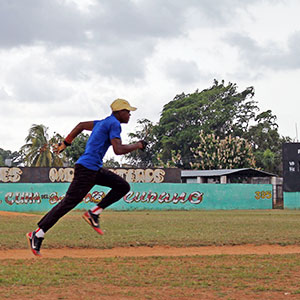
Cuba’s sports scene has been greatly influenced by its proximity to the United States. Baseball is Cuba’s official sport and the most popular. Cuba has also historically achieved success in amateur boxing, often winning medals at major competitions.
Students are taught to participate in track and field, basketball, baseball, gymnastics and volleyball in secondary school. Kids who excel compete in the Cuban Junior Olympics each year. Because of this focus on sports and physical education, Cuban athletes have gone on to win a total of 226 medals at the Olympic Games.
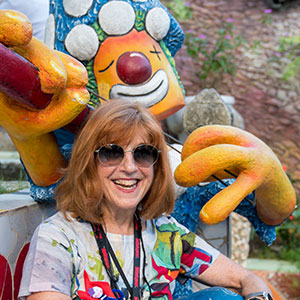
Cuban art is a visual feast for the eyes, containing colorful warm tones that reflect the tropical surroundings and diverse cultural makeup of the island. Artwork is a distinct blend of African, South American, European and North American influences.
Cuban literature began with poetry and has transformed since the early 19th century to include novels, essays and short stories. Themes of social activism and independence run throughout and many works by Cuban authors have been banned from the country’s bookshelves. Influential writers include José Martí, Gertrudis Gómez de Avellaneda, José María Heredia, Nicolás Guillén and many others. Earnest Hemingway’s “The Old Man and the Sea” was famously inspired by his fishing trips off Cuba’s coast.
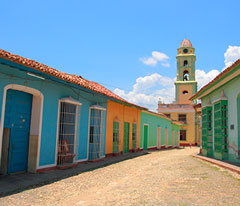
Cuban architecture is known for being colorful, eclectic and diverse. Walk down the streets of Havana and you’ll recognize architectural styles like Neoclassical and Baroque, often fused together in interesting ways. Spanish influences are strong and cities like Havana and Trinidad contain colonial buildings in bright pastel hues, from bubblegum pink to mint green.
“This Cuban adventure was an extraordinary combination of the historical and current situation of this magical island. The opportunity to support locals resulted in memorable experiences on a deeply personal level. My fascination with Cuba has increased by this truly unique adventure.”
— Joyce from Ferndale, California —
Cuba
See AllCuban History
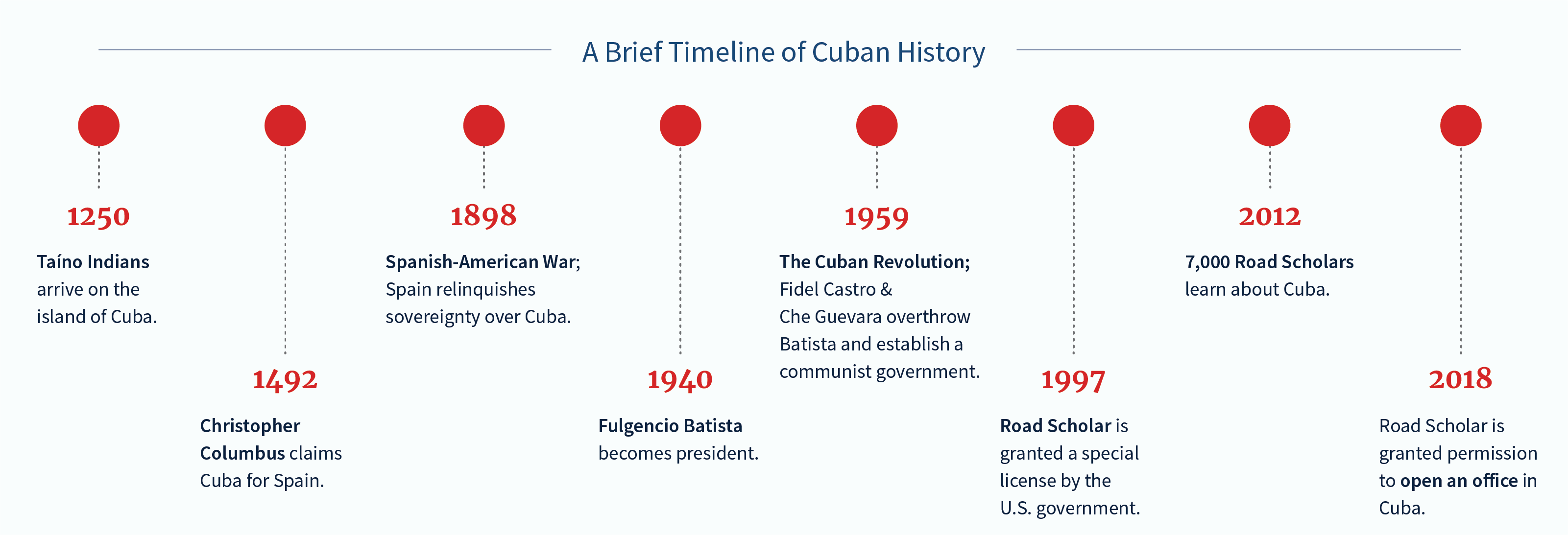
A Brief Timeline of Cuba's History
Before the arrival of Christopher Columbus in 1492, the island of Cuba was inhabited by the indigenous Taíno people. By 1514, they had been massacred by the Spanish conquistadors. The colony quickly began to prosper, thanks to its prime location as a trading outpost for the sugar and slave trades. There were several unsuccessful rebellions in the 19th century, but the Spanish eventually withdrew in 1898 after the Spanish-American war and Cuba gained independence in 1902.
Cuba saw an immediate jump in economic development, but was roiled with political corruption. A string of dictators ruled over the island before Fulgencio Batista was deposed in the revolution led by Fidel Castro and Che Guevara. Raúl Castro took over in 2008 because of his brother’s illness, and he soon started to enact capitalist reforms. The Obama Administration reestablished diplomatic relations with Cuba in 2015, but the embargo is still in place.
Is Cuba communist?
In short, yes. Cuba is governed by the Communist Party of Cuba, the only political party on the island. The government owns and operates everything from restaurants and hotels to telecommunications. Education, health, transportation, media and just about everything else are all socialized, meaning all Cubans pay for those goods and all Cubans get access to them.
Cuba’s relationship with the U.S.
Since Guevara and Castro overthrew Fulgencio Batista during the Cuban Revolution, Cuba has been governed as a socialist state under communist principles, thus prompting the U.S. to cut ties with the island during the Cold War in 1961. Then on July 20, 2015, Cuba and the United States restored diplomatic relations. U.S. diplomatic representation in Cuba is handled by the United States Embassy in Havana, and there is a similar Cuban Embassy in Washington, D.C. On March 20, 2016, President Barack Obama visited Cuba, becoming the first U.S. presidents in 88 years to visit the island. On June 16, 2017, President Donald Trump announced he was suspending a policy of unconditional sanctions relief for Cuba. On Nov. 8, 2017, the Trump administration announced that business and travel restrictions loosened by the Obama administration would be reinstated. On June 4, 2019, the Trump administration announced new restrictions on American travel to Cuba.
Road Scholar’s relationship with Cuba
Road Scholar has been taking Americans to Cuba since 1997. We can bring Americans to Cuba because we qualify under an approved travel category called "Support for the Cuban People," regulated by the Office of Foreign Asset Control (a division of the U.S. Treasury Department). The Trump administration’s announcement in June 2019 of new restrictions on American travel to Cuba did not affect Road Scholar. Thousands of people have learned about Cuba and have supported the locals through our learning adventures.
Important notes about your itinerary
Under the "Support for the Cuban People" license, the responsibility of documenting U.S. compliant travel to Cuba lies with the traveler. When you travel to Cuba with Road Scholar, we will provide an itinerary that is compliant with the "Support for the Cuban People" general license, along with a Proof of Compliance document to allow each participant to take notes on the itinerary and document your legal travel. If you should choose to take part in any activities not listed in the itinerary provided by Road Scholar, you are responsible for documenting what you chose to do instead of the scheduled activities and for ensuring that it is compliant with U.S. government regulations. We recommend that you keep the Proof of Compliance document and the Final Information Packet itinerary for at least five years after your trip to Cuba in the case of an audit by the U.S. government.
Cuban Geography & Nature
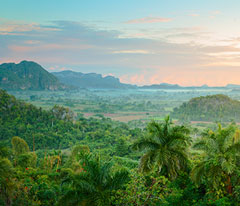
Cuba’s geography is relatively flat, with some rolling hills sprinkled throughout. Small mountain ranges like the Sierra Maestra and the Sierra Cristal rise up in the southeast, while white sand and mangrove marshes are spread along the coast. Cuba has many areas of unspoiled beauty, the most popular of which are its pristine, postcard-perfect beaches.
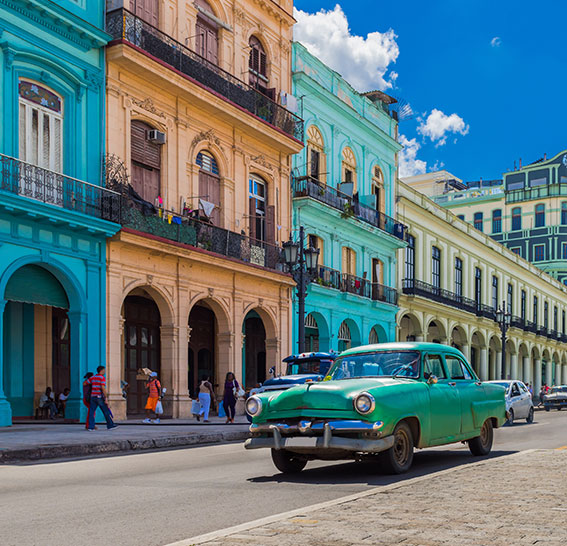

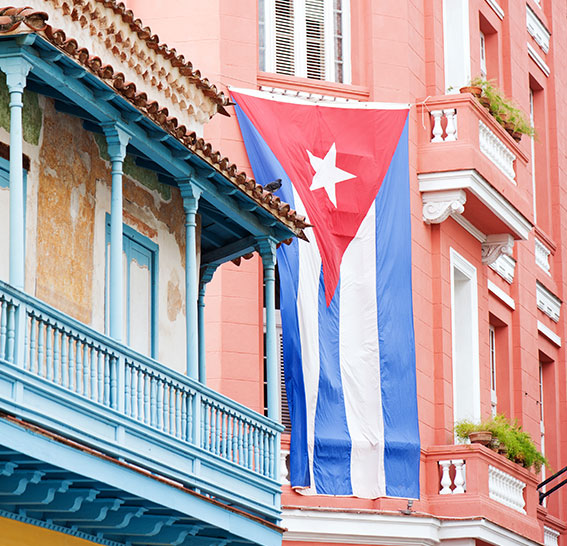
Havana
In 2019, Havana celebrated its 500th anniversary, a rare milestone that few cities in the Western Hemisphere have reached.
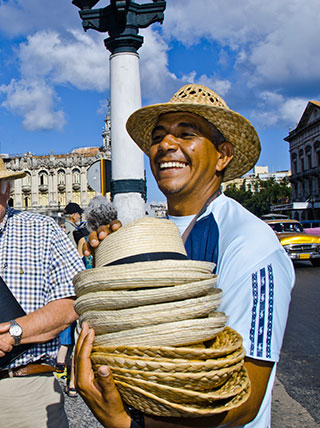
Over its tumultuous half millennia, Indians, Spaniards and other Europeans, Chinese and Americans have all contributed to Havana’s colorful character. These groups have imprinted their ideas, traditions and passions onto the city, all of which are apparent as you walk the streets and piece Havana together like you would an intricate jigsaw puzzle.
Free enterprise is slowly returning to Havana and private companies are experiencing solid growth. Restaurants and cafes show the unique creativity of the individuals who are renovating run down old buildings and instilling a spontaneous sense of excitement in their place. More important than the upgrades to attract more visitors from around the world is the impact the projects are having for every-day citizens. The National and City governments are working with citizens to instill better waste management and practices to improve city cleanliness. Thousands of buildings including pharmacies, family clinics, restaurants, bakeries and bodegas have been renovated and hundreds of educational centers have been improved for the next generation. A multi-faceted approach is being taken to help improve the day-to-day life of those who call Havana home. It is amazing how much Cuba is changing, how much is being preserved and restored, and how much isn’t changing at all.
Havana Fast Facts
- Population: 2.1 million
- Size: 120 square miles
- Known For: Historic museums and squares, live music, vintage cars, architectural fusion, artsy neighborhoods and Hemingway’s favorite haunts
“Havana is a fascinating city, starting to emerge from a time warp and bursting with new-found energy. The Cubans have unquenchable spirit, and are filled with joy. The experience will exceed your wildest expectations.”
— Freddie from Carmel, Indiana —
Guide to Top Attractions in Havana
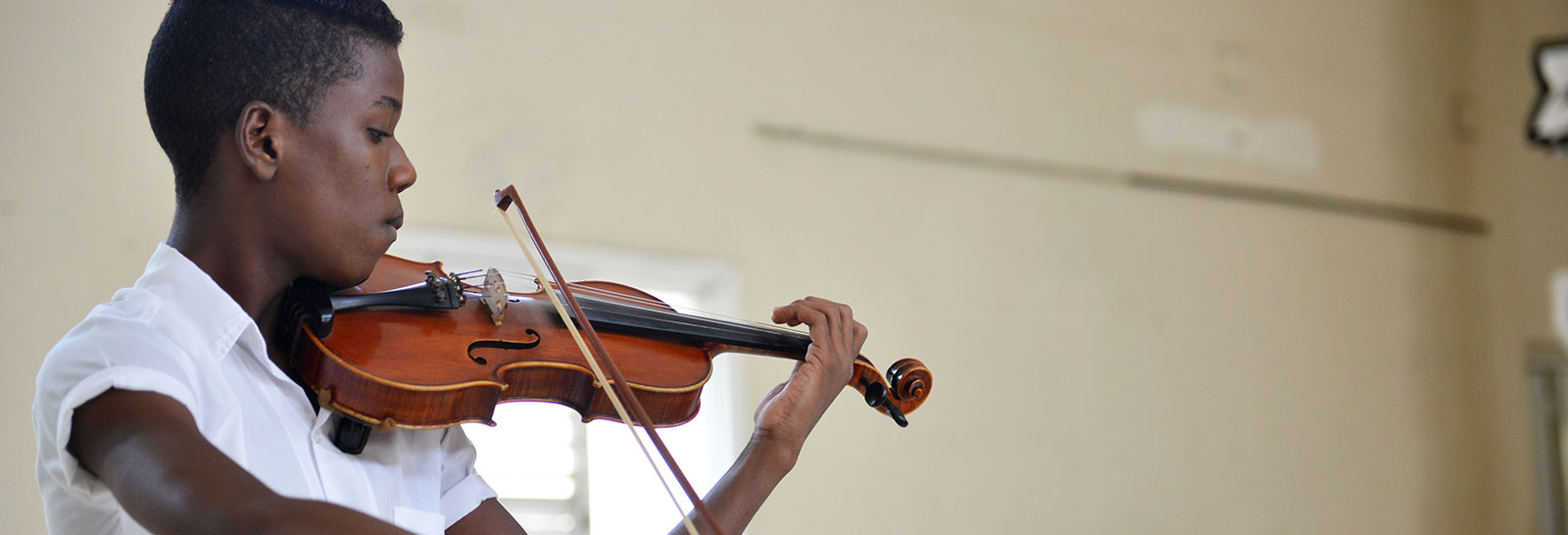
Can U.S. Citizens Travel to Cuba?
Travel to Cuba from the U.S. is allowed, but with certain restrictions.
Group travel is permitted through United States organizations under one of the 12 categories authorized by the U.S. Department of the Treasury’s Office of Foreign Assets Control (OFAC). Road Scholar travels under the “support for the Cuban people” category with compliant itineraries. As an educational travel organization, Road Scholar operates within these restrictions – in fact, we’ve been providing learning adventures to Cuba since 1997!
Americans can only go to Cuba with an authorized group that promotes activities that support Cuban people (or one of the other 11 approved categories of travel) – which is why Road Scholar is one of the leading organizations able to offer travel to Cuba. And if anything changes with these restrictions, rest assured that we will update you as soon as possible.
Cuba
See AllWhat to Expect When Traveling to Cuba
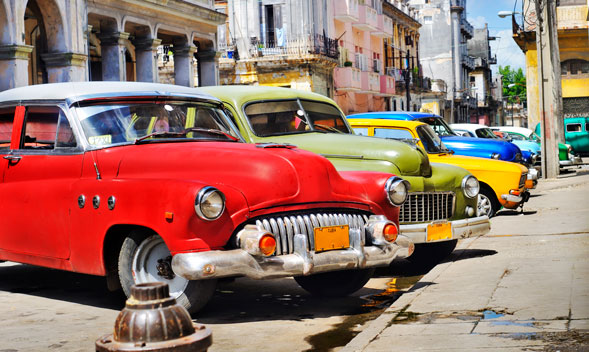
In general, public transportation in Cuba is scarce outside of major city limits. It’s possible to rent a car yourself at the Havana airport, but it can be tricky. Buses are a cheaper transportation option for visitors and traverse routes between popular destinations. These air conditioned coaches tend to fill up quickly however, and it can be difficult to book in advance.
Cuban taxis are available in most major cities and range from modern cars to old classics straight from the 1950s, known as almendrones. These classic cars operate more like miniature buses – following set routes and picking up people along the way. If you prefer, you can rent your own classic car and driver for a day.
Cuba travel tip alert! If you’re visiting Cuba with Road Scholar, you won’t have to worry about how you’re going to be traveling in Cuba. We’ll take care of all the arrangements for you, leaving you with more time to explore and learn!
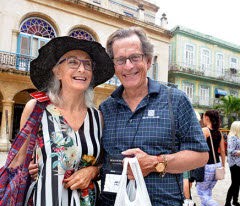
An important tip for traveling to Cuba is to bring U.S dollars in cash to exchange. ATMs are rare and most places don’t accept American credit cards. If you have easy access to foreign currency, like the British Pound or Canadian Dollar, you may want to bring it to avoid paying the penalty fee on American Dollars.
Check beforehand if your cell phone plan will work in Cuba. Some U.S. carriers like Sprint and Verizon have or are beginning to make agreements with ETECSA (the Cuban national telecommunications company) to offer roaming services in Cuba. If your carrier offers a roaming plan and your mobile phone is capable of roaming in Cuba, you should ask your carrier about any additional charges for voice calls, data, and outgoing text messages that you may incur during your trip. The telecommunications market in Cuba is changing rapidly, so before you travel, be sure to check with your wireless provider for the latest developments.
Cuba has limited internet access that is often slow and unreliable, especially outside of Havana. To get online you’ll need to buy an access card with a passcode that can be purchased from most hotels and some stores in town. You will need to be in a Wi-Fi hotspot to use the internet. Many hotels have a Wi-Fi area. However, hotels sometimes sell out of internet cards at the end of the day. You should plan on going off the grid when you are in Cuba.
While the majority of hotels and casa particulares in Cuba have U.S. standard three-prong outlets with a 110-volt current, it’s still possible to come across two-prong outlets up to 220 volts. Make sure personal appliances like hair dryers are rated for 110-volt current and carry the appropriate adapters with you.
“I left Cuba with an empathy and understanding of the Cuban people that I don't think I could've gotten on my own.”
— Donna from Silver Spring, Maryland —
Where to Stay in Cuba
From historic hotels to beachside resorts, there are a variety of options when it comes to where to stay in Cuba. One of our favorite Cuba travel tips is to stay at a casa particular, or a private family establishment akin to a bed and breakfast. It's a great way to make your travel experience truly authentic. Live like a local by booking your casa particular ahead of time with sites like Airbnb.
Cuba Travel Tips
If you’re planning a trip to Cuba, here are a few things to do before going to Cuba or tips to make the most out of your visit.
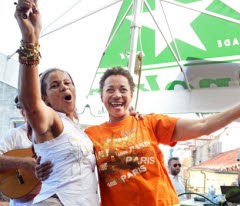
Learn some Spanish! All our groups are accompanied by a bilingual Cuban group leader and saying, “Hola” or, “Buenos Dias” is always appreciated. In addition to brushing up before traveling, there are a number of handy apps that are free to download on your phone that can help translate back and forth between English and dozens of other languages, including Google Translate for both Apple and Android devices.
Useful Spanish Phrases
- Buenos días. — Good morning.
- Buenas tardes. — Good afternoon.
- Buenas noches. — Good evening (greeting).
- Adios — Goodbye
- Si/No — Yes/No
- ¿Habla usted Inglés? — Do you speak English?
- Yo no hablo español. — I don’t speak Spanish.
- Si/No — Yes/No
- ¿Dónde está...? — Where is...?
- ¿Donde están los baños? — Where are the bathrooms?
- ¿Cuanto cuesta? — How much does it cost?
- No entiendo — I do not understand
- ¿Me puedes ayudar? — Can you help me?
- Muchas gracias. — Thank you very much
- De nada. — You’re welcome.
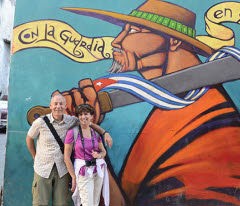
What to pack for Cuba:
- Bring cash in denominations ranging from $1, $5, $10, $20, and $50 bills. US cash is readily accepted for most transactions, and there is no reason to change to local currency. At Hotel Grand Aston you may be able to use your US credit card to purchase an MLC Cuban Cash card at a not very favorable rate. Our best advice is to stick to US cash whenever possible.
- Cuban visa
- Passport
- Credit card (even though ATMs are rare, it’s good to have)
- Comfortable walking shoes and sandals/flip flops
- Face cloth (many hotels do not have face cloths)
- Full med-kit (over-the-counter items like Advil, sunscreen, deodorant and tampons are expensive and hard to find in Cuba).

Persons authorized to travel to Cuba are only allowed to bring back art, handicrafts and any other articles produced by private businesses. Be aware that scammers are common – especially those who sell counterfeit cigars – and you should avoid buying items from street vendors. If you’re traveling with Road Scholar, your Group Leader will be able to point out the best places for you to purchase approved souvenirs.
Guide to the Best Places to Visit in Cuba
Still wondering where to go in Cuba? Here are a few of the best cities, historic sites and places to visit.
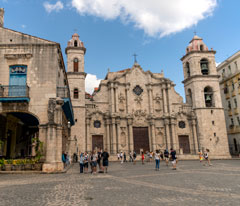
Now a UNESCO World Heritage Site, Old Havana (La Habana Vieja) was founded in 1519 and is the capital’s original city center. The five main plazas in Old Havana contain many of the city’s most notable attractions, from museums and memorials to Baroque cathedrals and colorful 17th-century colonial architecture. Listen to Cuban musicians perform lively music in historic Plaza Vieja or take a stroll along El Malecón, a seaside promenade with expansive views of the Gulf of Mexico.
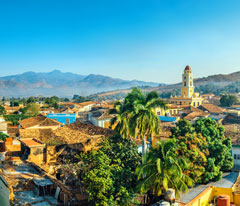
Trinidad is the second-oldest colonial city in Cuba and one of the best-preserved sugar-trade cities in the Caribbean. Its maze of dirt and cobbled streets are lined with brightly colored houses in hues of cornflower and sunflower, cantaloupe and key lime. Find your way to the cobbled Plaza Mayor, the center of the city, to admire this open-air museum of Spanish Colonial architecture, including the gold and sea foam tower of Convento de San Francisco.
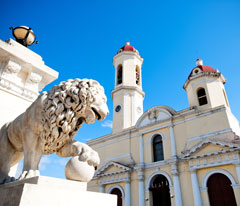
A UNESCO World Heritage Site, the city of Cienfuegos was founded by the French, who came to Cuba after the Haitian revolution. Examine the outstanding architecture and step inside the beautiful Tomas Terry Theatre to learn its history. Stroll down the main boulevard of Cienfuegos and stop in at the ration, Cuban pesos, and CUC stores, an opportunity to mingle with Cubans as they go about their daily life.
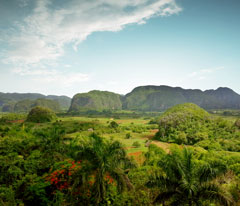
UNESCO declared Valle de Viñales a World Heritage Site in recognition of its unique landscape, unspoiled natural areas and traditional forms of agriculture still practiced by local farmers. Limestone mogotes draped in vegetation serve as backdrops to otherwise flat farmlands. For birders, target species at this site include Gundlach’s Hawk, White-crowned Pigeon, Snail Kite, Cuban Grassquit, Cuban Tody, Cuban Trogon, Cuban Green Wookpecker, and Yellow-headed Warbler.

Situated on Cuba’s southeastern coast, Santiago de Cuba is the country’s second-largest city known for its radical role in Cuban history. In the days of the Cuban Revolution, Castro famously declared victory from the balcony of city hall, but Santiago de Cuba has also made important contributions to Cuban culture. Salsa your way down the streets where poet José María Heredia lived, visit the site where Bacardí opened their first-ever rum factory and wander through the bayside fortress of Castillo de San Pedro de la Roca, a perfect example of Spanish-American military architecture.
Cuba Travel Tip: Read Up Before You Go
Road Scholar Cuba Travel Blogs
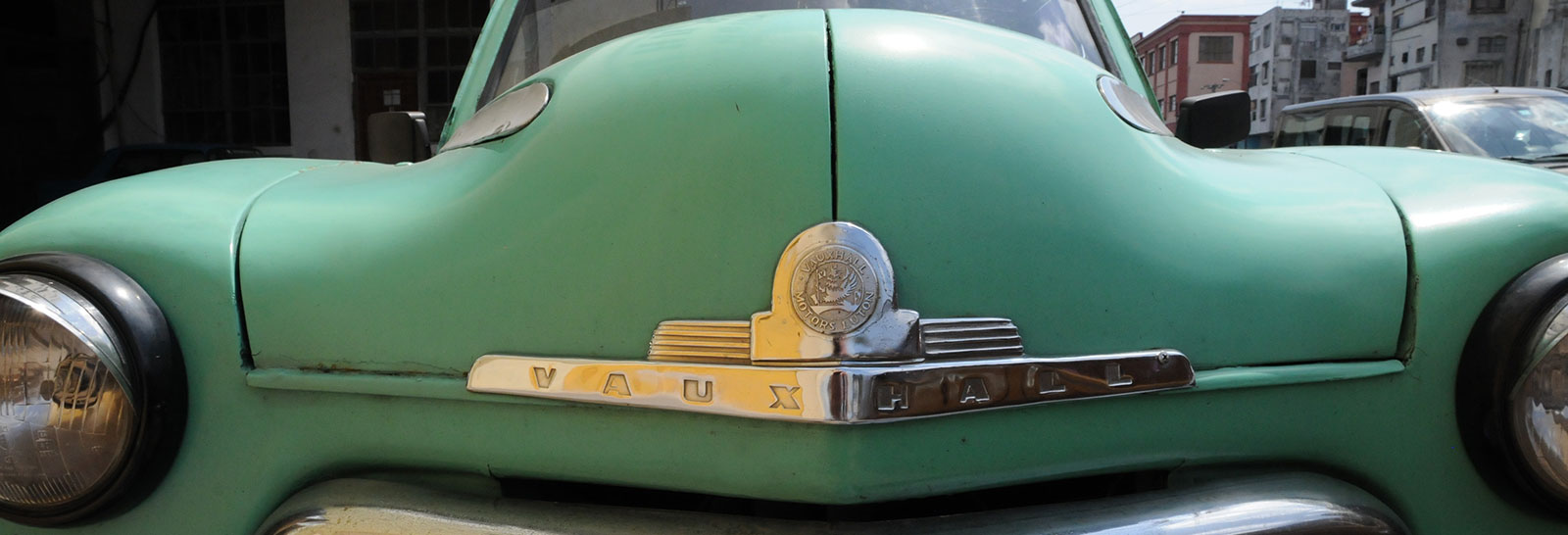
Recommended Reading for Your Trip to Cuba
The Cuba Reader: History, Culture, Politics by Aviva Chomsky (Editor), Barry Carr (Editor), Pamela Maria Smorkaloff (Editor)
Organized chronologically, this multi-faceted portrait of a nation, with most of the selections by Cuban writers, includes not only history, journalism and literature but also songs, paintings, poems, cartoons and speeches.
Cuba by Pierre Hausherr (Photographer), Francois Missen
With full-page photographs, introductory essays on history, architecture, music, food and more, this oversized, illustrated paperback by Pulitzer-prize winning journalist Francois Missen and photographer Pierre Hausherr captures the spirit of Cuba, its people, nature and culture.
Trading with the Enemy by Tom Miller
Miller captures the openness, sensuality and pride of Cuba and the Cubans in this eloquent account of entertaining travels in Fidel's Cuba.
Listen, Yankee, Why Cuba Matters by Tom Hayden
With an unabashedly liberal bias, Hayden insightfully covers the often troubled relationship between these two nations and brings readers to the present with consideration for the future of U.S.-Cuban relations.
The Old Man and the Sea by Ernest Hemingway
The best-known novel about Cuba written by a non-Cuban author. The story tells of a Cuban fisherman’s best catch and his enduring spirit. The novel won Hemingway the Nobel prize and was inspired by the many years he spent on the island.
Che Guevara, A Revolutionary Life by Jon Lee Anderson
A revised and updated edition of Anderson's definitive biography, published to mark the 50th anniversary of the Cuban Revolution.
Cuba, What Everyone Needs to Know by Julia Sweig
Director for Latin America Studies at the Council on Foreign Relations, Sweig traces the geography, history and identity of Cuba in this admirably succinct history of the island nation and its role in world affairs.
Our Man in Havana by Graham Greene
The story of a British vacuum cleaner salesman who gets accidentally drawn into Cold War espionage with disastrous (and hilarious) results. Published in 1958, months before Castro and his men swept into Havana, the story is a portrait of an immensely corrupt, pre-revolutionary society.
Hemingway's Boat: Everything He Loved in Life and Lost by Paul Hendrickson
Focusing on the years 1934 to 1961, from Hemingway's pinnacle as the reigning monarch of American letters until his suicide, Paul Hendrickson traces the writer's life through the story of his beloved boat, Pilar.
Dreaming in Cuban by Cristina Garcia
A short, poetic novel of three generations of Cuban women, their reaction to the revolution and the complex relation between those who remained in Cuba and those who settled in the United States. Excellent reading.

